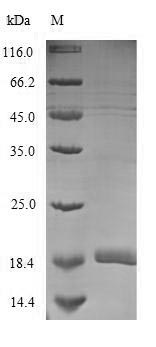Recombinant Mouse Complement receptor type 2 (Cr2) is produced in a mammalian cell expression system, which appears to ensure proper folding and post-translational modifications. This partial protein spans amino acids 12 to 145 and comes with an N-terminal 6xHis and Myc tag for easier purification and detection. SDS-PAGE verification shows the protein achieves greater than 90% purity, making it suitable for various research applications.
Complement receptor type 2 (CR2) represents an important component of the immune system. It's primarily involved in regulating B cell activation and response, though its full role may be more complex than initially understood. The receptor binds complement component C3d and likely plays a part in immune complex clearance. CR2 appears critical for adaptive immunity, and studying it could provide valuable insights into how immune function and regulation actually work.
Potential Applications
Note: The applications listed below are based on what we know about this protein's biological functions, published research, and experience from experts in the field. However, we haven't fully tested all of these applications ourselves yet. We'd recommend running some preliminary tests first to make sure they work for your specific research goals.
Mouse Cr2 is a transmembrane glycoprotein that requires precise folding, proper disulfide bond formation, glycosylation, and specific tertiary structure for its functional activity in complement binding and immune regulation. The mammalian cell expression system provides the eukaryotic folding environment necessary for correct disulfide bond formation and potential glycosylation. However, the partial fragment (12-145aa) represents only a small portion of the full-length protein and lacks critical domains, including the transmembrane region and cytoplasmic tail. The dual N-terminal 6xHis-Myc tag may cause steric interference with the protein's functional domains. While mammalian expression favors proper folding, the probability of correct folding with functional complement-binding activity requires experimental validation due to the truncated nature and potential tag interference.
1. Protein-Protein Interaction Studies
This application carries a significant risk without functional validation. Cr2 interactions with complement components (e.g., C3d) require precise tertiary structure and proper domain conformation. If correctly folded and active (verified through binding assays), the protein may identify physiological interaction partners. If misfolded/unverified, there is a high risk of non-specific binding or failure to replicate genuine ligand-receptor interactions.
2. Antibody Development and Validation
This application is highly suitable as antibody development relies on antigenic sequence recognition. The mammalian-expressed protein provides proper folding and relevant post-translational modifications, making it an excellent immunogen for generating antibodies that recognize native Cr2 epitopes within the 12-145aa region.
3. Structural and Biochemical Characterization
These studies are essential for determining folding status. The mammalian expression system supports proper folding, making techniques like circular dichroism spectroscopy and dynamic light scattering valuable for assessing the structural properties of this Cr2 fragment.
4. Cell-Based Binding and Uptake Assays
This application carries significant limitations. While the soluble extracellular domain fragment can be used for binding studies, it lacks the transmembrane domain required for physiological receptor function and cellular uptake. Binding data may not reflect native receptor behavior, and uptake studies are fundamentally impossible without full-length receptor expression.
Final Recommendation & Action Plan
The mammalian-expressed Cr2 extracellular domain fragment has a moderate probability of correct folding due to the appropriate expression system, but its functional applications are limited by the small size (12-145aa represents only a portion of the extracellular domain) and lack of a transmembrane domain. Begin with Application 3 (Structural Characterization) to validate folding quality through techniques like CD spectroscopy and SEC. Application 2 (antibody development) can proceed immediately. Applications 1 and 4 require rigorous validation of complement-binding functionality before use. For complete Cr2 studies, use full-length protein or larger extracellular domain constructs expressed in mammalian systems.







